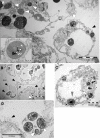Expulsion of symbiotic algae during feeding by the green hydra--a mechanism for regulating symbiont density?
- PMID: 18596972
- PMCID: PMC2432043
- DOI: 10.1371/journal.pone.0002603
Expulsion of symbiotic algae during feeding by the green hydra--a mechanism for regulating symbiont density?
Abstract
Background: Algal-cnidarian symbiosis is one of the main factors contributing to the success of cnidarians, and is crucial for the maintenance of coral reefs. While loss of the symbionts (such as in coral bleaching) may cause the death of the cnidarian host, over-proliferation of the algae may also harm the host. Thus, there is a need for the host to regulate the population density of its symbionts. In the green hydra, Chlorohydra viridissima, the density of symbiotic algae may be controlled through host modulation of the algal cell cycle. Alternatively, Chlorohydra may actively expel their endosymbionts, although this phenomenon has only been observed under experimentally contrived stress conditions.
Principal findings: We show, using light and electron microscopy, that Chlorohydra actively expel endosymbiotic algal cells during predatory feeding on Artemia. This expulsion occurs as part of the apocrine mode of secretion from the endodermal digestive cells, but may also occur via an independent exocytotic mechanism.
Significance: Our results demonstrate, for the first time, active expulsion of endosymbiotic algae from cnidarians under natural conditions. We suggest this phenomenon may represent a mechanism whereby cnidarians can expel excess symbiotic algae when an alternative form of nutrition is available in the form of prey.
Conflict of interest statement
Figures


References
-
- Rosenberg E, Koren O, Reshef L, Efrony R, Zilber-Rosenberg I. The role of microorganisms in coral health, disease and evolution. Nat Rev Microbiol. 2007;5(5):355–362. - PubMed
-
- Douglas AE. Coral bleaching - how and why? Mar Pol bull. 2003;46:385–392. - PubMed
-
- Merle PL, Sabourault C, Richier S, Allemand D, Furla P. Catalase characterization and implication in bleaching of a symbiotic sea anemone. Free Radic Biol Med. 2007;42(2):236–246. - PubMed
-
- Richier S, Sabourault C, Courtiade J, Zucchini N, Allemand D, et al. Oxidative stress and apoptotic events during thermal stress in the symbiotic sea anemone, Anemonia viridis. FEBS J. 2006;273(18):4186–4198. - PubMed
-
- McAuley PJ. The cell cycle of symbiotic Chlorella. III. Numbers of algae in green hydra digestive cells are regulated at digestive cell division. J Cell Sci. 1986;85:63–71. - PubMed
Publication types
MeSH terms
LinkOut - more resources
Full Text Sources

